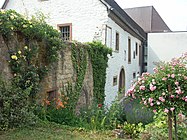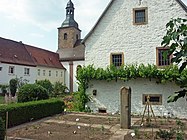Imperial monastery Klingenmünster
| Blidenfeld Monastery | ||
|---|---|---|
 The monastery complex |
||
| Data | ||
| place | Klingenmünster | |
| Client | Black monks, Dagobert I. | |
| Architectural style | Romanesque | |
| Construction year | probably 626 | |
| Coordinates | 49 ° 8 '22.9 " N , 8 ° 1' 9.5" E | |
|
|
||
The Klingenmünster Monastery was an imperial monastery that was located in the area of what is now the southern Palatinate municipality of Klingenmünster and was the nucleus of this monastery . Originally it was also called "Blidenfeld Monastery".
history
founding
The monastery was probably built in 626, during the reign of the Merovingian king Dagobert I (622–639). There are only the following indications for this date:
- The foundation of the monastery goes back to the so-called "black monks", who represented the teaching of Columban . These monks built numerous monasteries in France , Germany and Italy in the 7th century . Dagobert I was a patron of Columban and thus the founder of numerous facilities. In the 8th century, Columban's teaching was replaced by Benedict's teaching .
- King Dagobert I arranged the legal relations of the Haingeraide . There is only a gap in the uninterrupted train of the Alsatian and Palatinate Geraiden, which stretched from Wanzenau in Alsace to Bad Dürkheim in the Palatinate along the Vosges and Haardt . This gap coincides with the holdings of the Klingenmünster monastery.
- In 1737 the dilapidated Romanesque abbey church underwent a baroque transformation. In a memo from the year 1737, the pastor reported to the higher church authority that the “local clock old aO 626 built collegiate and parish church” is to be torn down and rebuilt. The pastor at the time could only have read this year in a building inscription , because in the turmoil of the Thirty Years War all files and holdings were destroyed.
Further development
On July 25, 782, Charlemagne confirmed to the Church of Speyer under Bishop Flaido (also Fraido ) the waiver of taxes. In the 1st Reichenau fraternization list, Flaido is named as Abbot of Klingenmünster. The list itself does not contain a year, but Flaido is already known as Bishop of Speyer from 780 onwards .
Around the year 840 the residential buildings of the monastery and the church roof burned down. All documents of the monastery were lost. The monks therefore asked Archbishop Otgar von Mainz for support and the reconstruction of the monastery. In a St. Gallen monk list Otgar is named as Abbot of Klingenmünster. The 2nd Reichenau fraternization list represents a correction of the Sankt Gallen monk list, Otgar is listed here as abbot of Klingenmünster with the addition of archbishop .
In the 9th century was Hatto I. abbot of the monastery Klingenmünster Empire.
Heyday of the monastery
In the 11th century, another figure emerged from the Klingenmünster convent . Monk Gottschalk von Aachen is verifiably active as a clerical notary of Heinrich IV in the imperial chancellery from 1071 to 1084 . The monk himself received his training in Klingenmünster from the monk Heinrich. Heinrich was a great "songwriter" of his time. After finishing his work, Gottschalk returned to Klingenmünster.
In the 12th century, Abbot Stephan (1094–1114) laid another cornerstone for the monastery's heyday. The monastery property was increased considerably through donations, foundations and cheap purchases. Stephan came from the Ebersheim monastery and was already abbot of Weißenburg , Selz and Limburg before he also became abbot of Klingenmünster in 1110. In return, monk Konrad von Klingenmünster became abbot in Ebersheimmünster in 1110.
In 1115 the abbey was freed from all royal, episcopal and parochial services and burdens by Adalbert I of Saarbrücken , Archbishop of Mainz . However, this was not entirely without reason. Adalbert I was a count of Saarbrücken and tried to bring his relatives in Klingenmünster into office and dignity.
At the beginning of the 13th century, large parts of the monastery property had already been sold again and passed into the possession of the Counts of Leiningen and Zweibrücken. These also descend in a straight male line from the Counts of Saarbrücken.
In 1223 Pope Honorius III. the monastery under the special protection of the Roman see.
Fall of the monastery
Through the various disposals of the monastery property, the economic and political influence dwindled. The noble families in the area let their later sons enter the monastery for reasons of supply. Over the course of time, this resulted in a lively number of visitors from relatives, which is why the monastery and the religious order fell into disrepair in the second half of the 15th century.
In 1452, Archbishop Dietrich von Mainz called on the abbey to improve discipline in a warning letter. Abbot Bernhard (1440-1457) laid down the abbot dignity in 1457 because he could not meet the requirements of the warning letter. His successor Abbot Erpfo Brack von Klingen (1458–1483) did not carry out the necessary reform either. The reform proposals of a renewed warning letter from Bishop Matthias von Rammung from 1469 were also not implemented.
In 1490 there were only four convent members left in the abbey, which is why Pope Innocent VIII converted the abbey into a secular canon on November 18, 1490 . The last abbot Eucharius von Weingarten (1483-1490) was raised to the rank of first provost .
During the tenure of the third provost, Johann (1499–1506), the monastery suffered from a Bavarian feud and the Landshut War of Succession . In order to ward off the ruin of the monastery, provost Johann pledged various villages. Despite repeated letters of protection from the emperor , the monastery was looted by the farmers of Pleisweiler and Oberhofen during the Peasants' War in 1525 . Leonhard Schnorr (1530–1538) took over the monastery as the fifth and last provost. The office of provost was probably withdrawn for reasons of economy, because from 1538 the dean took over the management of the monastery.
With the advancement of the Reformation and the split in faith came the decline of the monastery. Elector Friedrich III. introduced the teaching of Johannes Calvin in the Electoral Palatinate . Between 1565 and 1567, all monasteries were closed and the facilities destroyed. In 1567 the aged dean Johann Ziegler died as the last bearer of the dean of the monastery. The custodian Niklaus Will then handed over all documents, files and registers to the Palatinate officials. Thus secularization was completed. Niklaus Will became the first secular dean.
Today's pictures
literature
- Georg Biundo : Art. Klingenmünster. In: Ludwig Petry (ed.): Handbook of the historical sites of Germany . Volume 5: Rhineland-Palatinate and Saarland (= Kröner's pocket edition . Volume 275). 3rd revised edition. Kröner, Stuttgart 1988, ISBN 3-520-27503-1 , pp. 175-176.
- Michael Borgolte: The convent of Klingenmünster Abbey in Carolingian times. In: Archive for Middle Rhine Church History 29 (1977), pp. 25–37.
- Albert Decker: The Benedictine Abbey of Klingenmünster from the Merovingian to the Staufer period. In: Archive for Middle Rhine Church History 2 (1950), pp. 9–87.
- Albert Decker: Reformation, secularization and reintroduction of the Catholic cult in Klingenmünster Abbey. In: Archive for Middle Rhine Church History 10 (1958), pp. 112-164.
- Egon W. Emmering (Ed.): Monasterium Clinga jubilans. Festschrift for the inauguration of the restored east wing of the former Benedictine Abbey of Klingenmünster , Klingenmünster 1995.
- Hans Fell: Klingenmünster. In: Friedhelm Jürgensmeier / Regina Elisabeth Schwerdtfeger (edit.): The Benedictine monasteries for men and women in Rhineland-Palatinate and Saarland , (Germanica Benedictina. Vol. 9), St. Ottilien 1999, pp. 230-259.
- Franz Haffner: The conversion of the Benedictine Abbey of St. Michael to Klingenmünster into a collegiate monastery (1490). In: Studies and communications on the history of the Benedictine order and its branches 78 (1967), pp. 325–328.
- Thorsten Unger / Martin Wenz / Matthias Untermann: Klingenmünster, St. Michael, (Benedictine) monastery, later collegiate monastery. In: Jürgen Keddigkeit / Matthias Untermann / Hans Ammerich / Pia Heberer / Charlotte Lagemann (eds.): Palatinate Monastery Lexicon. Kaiserslautern 2014, part 2, pp. 484-519.
- Thorsten Unger: Klingenmünster and the Electoral Palatinate in the 15th and 16th centuries. Studies on the aspect of “monastery and rule” using the example of a rural collegiate monastery , (Foundation for the Promotion of Palatinate Historical Research , Series B: Treatises on the History of the Palatinate, Vol. 10), Neustadt an der Weinstraße 2009.
Web links
- Information about Klingenmünster
- Film about Klingenmünster Monastery on YouTube
- Freundeskreis Kloster Klingenmünster eV with a historical overview and a series of pictures



